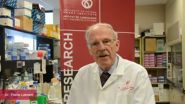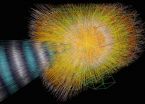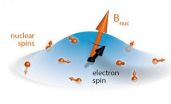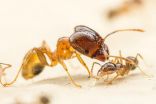INFORMATION:
All works published in PLOS Computational Biology are Open Access, which means that all content is immediately and freely available. Use this URL in your coverage to provide readers access to the paper upon publication: http://www.ploscompbiol.org/article/info:doi/10.1371/journal.pcbi.1003866
Author Contact
Michael Prerau
Massachusetts General Hospital
Department of Anesthesia,
Critical Care, and Pain Medicine
646-644-6453
prerau@nmr.mgh.harvard.edu
Citation
Prerau MJ, Hartnack KE, Obregon-Henao G, Sampson A, Merlino M, et al. (2014) Tracking the Sleep Onset Process: An Empirical Model of Behavioral and Physiological Dynamics. PLoS Comput Biol 10(10): e1003866. doi:10.1371/journal.pcbi.1003866
Funding
Research supported by an NIH New Innovator Award DP2-OD006454, (PLP) http://commonfund.nih.gov/newinnovator/index. The funders had no role in study design, data collection and analysis, decision to publish, or preparation of the manuscript.
Competing Interests
MJP and PLP have patents pending on the monitoring of sleep and anesthesia. MTB has a patent pending for a sleep monitoring device, has consulting agreements with Sunovion on drug-development (less than $2000 anticipated in 2014, the first year of the relationship) and is on the clinical advisory board for Foramis (less than $2000 anticipated in 2014, the first year of the relationship). JME received an honorarium ($1000) from presenting Grand Rounds. All other authors have declared that no competing interests exist.
About PLOS Computational Biology
PLOS Computational Biology features works of exceptional significance that further our understanding of living systems at all scales through the application of computational methods. All works published in PLOS Computational Biology are Open Access. All content is immediately available and subject only to the condition that the original authorship and source are properly attributed. Copyright is retained. For more information follow @PLOSCompBiol on Twitter or contact ploscompbiol@plos.org.
About PLOS
PLOS is a nonprofit publisher and advocacy organization founded to accelerate progress in science and medicine by leading a transformation in research communication. For more information, visit http://www.plos.org.
Falling asleep: Revealing the point of transition
2014-10-02
(Press-News.org) How can we tell when someone has fallen asleep? To answer this question, scientists at Massachusetts General Hospital have developed a new statistical method and behavioural task to track the dynamic process of falling asleep.
Dr Michael Prerau, Dr Patrick Purdon, and their colleagues used the evolution of brain activity, behaviour, and other physiological signals during the sleep onset process to automatically track the continuous changes in wakefulness experienced as a subject falls asleep.
The study, publishing today in PLOS Computational Biology, suggests that it is not when one falls asleep, but how one falls asleep that matters. Using these methods, the authors quantified a subset of healthy subjects who behaved as though they were awake even though their brains, by current clinical definitions, were asleep.
Understanding the process of falling asleep is an important problem in neuroscience and sleep medicine. Given that current clinical methods are time-consuming, subjective, and simplify the sleep onset process in ways that limit the accuracy, the authors combine the state-of-the-art in neuroscience and signal processing to design an accurate and efficient way to characterise sleep.
The researchers replaced a standard measure, the behavioural response task, which uses sounds that can disturb sleep, with a new task centred on a subject's focused natural breathing – an act which may even promote sleep. They modeled the physiological and behavioural changes occurring during sleep onset as a continuum that can develop gradually over time.
The identification of some subjects who continued to perform the task even though current clinical measures would say they were asleep suggests a natural variation in the way cortical and thalamic networks interact in these people.
"Ultimately, such methods could greatly improve clinicians' ability to diagnose sleep disorders and to more precisely measure the effects of sleep drugs and other medications," remarked Dr Prerau.
Future work will look to improve the understanding of the mechanisms underlying neural dynamics during sleep, as well as the development of more sophisticated diagnostic and monitoring tools.
ELSE PRESS RELEASES FROM THIS DATE:
Researchers identify new pathway linking the brain to high blood pressure
2014-10-02
VIDEO:
Dr. Frans Leenen, from the University of Ottawa Heart Institute, discusses the importance of these new findings.
Click here for more information.
Ottawa, ON and Baltimore, MD, October 2, 2014—New research by scientists at the Ottawa Heart Institute and the University of Maryland School of Medicine (UM SOM) has uncovered a new pathway by which the brain uses an unusual steroid to control blood pressure. The study, which also suggests new approaches for treating high blood ...
York academics reveal new findings about insect diversification
2014-10-02
Biologists from the University of York have compiled two new datasets on insect evolution, revealing that metamorphosing insects diversify more quickly than other insects and are therefore the biggest contributors to the evolution of insect diversity.
Both funded by the Natural Environment Research Council (NERC), the first dataset is a complete fossil catalogue showing timescales of origination and extinction of different families of insects. Working with the Natural History Museum and National Museums Scotland, former PhD student Dr David Nicholson collated a database ...
A closer look at the perfect fluid
2014-10-02
By combining data from two high-energy accelerators, nuclear scientists have refined the measurement of a remarkable property of exotic matter known as quark-gluon plasma. The findings reveal new aspects of the ultra-hot, "perfect fluid" that give clues to the state of the young universe just microseconds after the big bang.
The multi-institutional team known as the JET Collaboration, led by researchers at the U.S. Department of Energy's Lawrence Berkeley National Lab (Berkeley Lab), published their results in a recent issue of Physical Review C. The JET Collaboration ...
Supreme delay: Why the nation's highest court puts off big decisions until the last moment
2014-10-02
As the Supreme Court of the United States begins its fall 2014 session this month, it faces decisions on several "blockbuster" cases, including freedom of speech, religious freedoms in prison, pregnancy discrimination and a possible decision on gay marriage.
Just don't expect any of these decisions until next June, just before the court's session ends.
New research from the Washington University in St. Louis School of Law finds big, or "blockbuster," cases are disproportionately decided at the end of June, just before the court's summer recess.
"We knew that more than ...
Washington University review identifies factors associated with childhood brain tumors
2014-10-02
Older parents, birth defects, maternal nutrition and childhood exposure to CT scans and pesticides are increasingly being associated with brain tumors in children, according to new research from the Brown School at Washington University in St. Louis.
Brain and central nervous system tumors are the second leading cause of cancer death in children.
A team of researchers, led by Kimberly Johnson, PhD, assistant professor of social work at the Brown School, a member of the Institute for Public Health and a research member of Siteman Cancer Center, examined studies published ...
Quantum environmentalism
2014-10-02
Where are the quantum computers? Aren't they supposed to be speeding up decryption and internet searches? After two decades of research, you still can't find them in stores. Well, it took two decades or more of research dedicated to semiconductors and circuit integration before we had digital computers. For quantum computers too it will take technology more time to catch up to the science
Meanwhile, research devoted to exploring bizarre quantum phenomena must continue to overcome or reduce a litany of practical obstacles before quantum computing can be realized. ...
A discovery could prevent the development of brain tumours in children
2014-10-02
Montréal, October 2, 2014 – Scientists at the IRCM discovered a mechanism that promotes the progression of medulloblastoma, the most common brain tumour found in children. The team, led by Frédéric Charron, PhD, found that a protein known as Sonic Hedgehog induces DNA damage, which causes the cancer to develop. This important breakthrough will be published in the October 13 issue of the prestigious scientific journal Developmental Cell. The editors also selected the article to be featured on the journal's cover.
Sonic Hedgehog belongs to a family of proteins that gives ...
Study: Big-headed ants grow bigger when faced with fierce competitors
2014-10-02
CHAMPAIGN, Ill. — The big-headed ant (Pheidole megacephala) is considered one of the world's worst invasive ant species. As the name implies, its colonies include soldier ants with disproportionately large heads. Their giant, muscle-bound noggins power their biting parts, the mandibles, which they use to attack other ants and cut up prey. In a new study, researchers report that big-headed ant colonies produce larger soldiers when they encounter other ants that know how to fight back.
The new findings appear in the Biological Journal of the Linnean Society.
Big-headed ...
Blackflies may be responsible for spreading nodding syndrome
2014-10-02
London, United Kingdom, October 2, 2014 – Despite decades of research, scientists have yet to pinpoint the exact cause of nodding syndrome (NS), a disabling disease affecting African children. A new report suggests that blackflies infected with the parasite Onchocerca volvulus may be capable of passing on a secondary pathogen that is to blame for the spread of the disease. New research is presented in the International Journal of Infectious Diseases.
Concentrated in South Sudan, Northern Uganda, and Tanzania, NS is a debilitating and deadly disease that affects young ...
Unexpectedly speedy expansion of human, ape cerebellum
2014-10-02
A new study published in the Cell Press journal Current Biology on October 2 could rewrite the story of ape and human brain evolution. While the neocortex of the brain has been called "the crowning achievement of evolution and the biological substrate of human mental prowess," newly reported evolutionary rate comparisons show that the cerebellum expanded up to six times faster than anticipated throughout the evolution of apes, including humans.
The findings suggest that technical intelligence was likely at least as important as social intelligence in human cognitive ...




